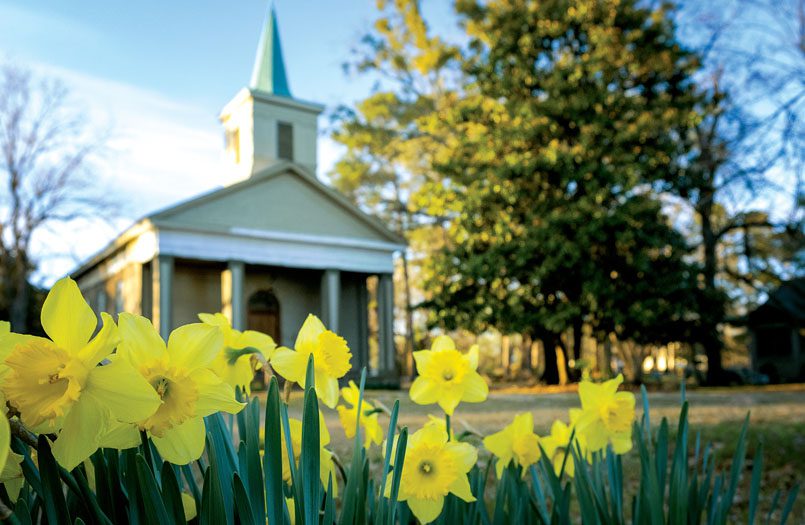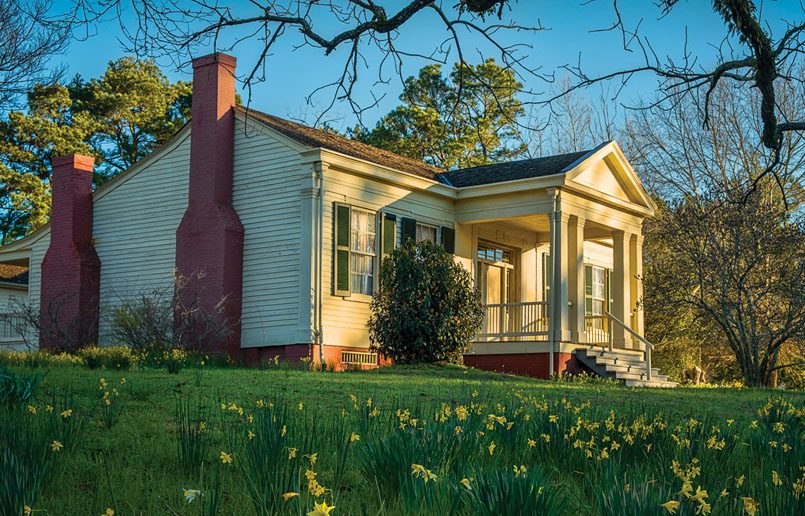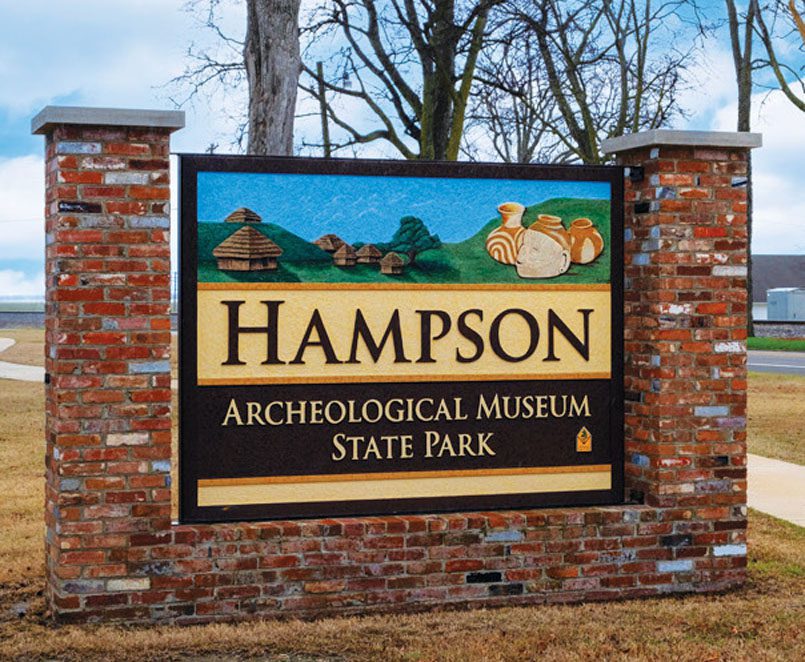02 Aug 2022 An Arkansas state parks grand adventure, Part 2
Story and photos by Linda Henderson
So, to recap from last month’s story: How do you fill the time of a man who must be busy but still needs time to heal and recover from shoulder surgery? You start the “visit all of The Arkansas State Parks while Jim recovers from shoulder surgery tour.” Last month, I wrote about the scenic parks. This month, let’s visit the historical parks.
During our tour, we took steps back in time and watched Arkansas history unfold at our historical parks. We explored the history of the state’s earliest dwellers to the oil boom of the 1900s. During our visits, we saw Civil War battlefields, hundreds of landmarks, historical churches, and other inspiring sites.

Jim and I found 20 parks that we categorized as historical themed parks, and 18 are named here: Lower White River Museum, Plantation Agriculture Museum, Toltec Mounds, Ozark Folk Center, Davidsonville Historic, Hampson Archeological Museum, Harman Davis, Jacksonport, Parkin Archeological, Powhatan Historic, Arkansas Post Museum, Louisiana Purchase, Arkansas Museum of Natural Resources, Conway Cemetery, Historic Washington, Red River Campaign, Prairie Grove, and Lake Fort Smith.
The rivers of Arkansas served as the first transportation systems into the frontier. Arkansas is abundant in rivers and streams. According to the Encyclopedia of Arkansas, there are approximately 90,000 miles of waterways. Thirty-three rivers pass through Arkansas. These rivers were the “superhighways” of the 19th century and for thousands of years prior to statehood. Native people, early explorers, and pioneers all came to Arkansas by canoes, flat boats, keel boats, ferries, and later steamboats. Many of Arkansas’s first towns and cities were established close to the rivers. Arkansas’s river history is celebrated by several of our state parks.
Lower White River Museum State Park is in Des Arc. The museum theme is the role that the White River played in the development of the state. White River was a vital transportation route for the early Arkansas pioneers. The river provided a waterway for fishing, hunting, transportation of timber, and harvesting mussel shells for pearls and mother of pearl buttons.
During our tour of Arkansas’ Upper Delta, we visited multiple historical parks, which are all within a day’s drive. They are a wonderful mixture of early Arkansas history and development of the state’s infrastructure.

Davidsonville Historical Park State Park is outside of Pocahontas. The park is on the site of Arkansas’ first post office and earliest courthouse. Little remains of the early townsite. A trail system wanders through the woods, follows the historical townsite, and passes through a post-Civil War cemetery.
Powhatan (pronounced pau-uh-tan) Historic State Park is in Powhatan. The park has six preserved buildings from the 19th century. The park’s site sits high on an overlook of the Black River.
The town was named for the Native American chief who was the father of Pocahontas. During the 1800s, the site was a steamboat port and had a ferry embarkment. It was the area’s primary shipping port for the territory.
Jacksonport State Park is located near New Port. It sits on the confluence of the White and Black Rivers. During the Civil War, Jacksonport was the county seat and was a busy port for the transport of goods in and out of eastern Arkansas. The courthouse on the grounds has been restored and is a part of the park’s museum. The park has a beautiful half-mile riverwalk that is a perfect way to stretch your legs.
Arkansas has three parks that explore the state’s early Native Americans’ history, culture, and heritage. Two are in the Upper Delta and one is in Central Arkansas.
Hampson State Park is located on the town square in Wilson, Arkansas. This museum/park contains a nationally renowned collection of artifacts from the Nodena People, who inhabited the area from 1400 to 1650.
Parkin Archeological State Park is on the banks of the Saint Francis River. The park preserves the history and culture of people living in the Mississippi Delta during the time of 1000 AD to 1550. There is evidence that the expedition of Spanish explorer Hernando de Soto visited the area in 1541.
Toltec Mounds Archeological State Park is a National Landmark. It is near Scott. Toltec is one of the largest and most important archeological sites in the Mississippi River Valley. The site was a ceremonial ground for prehistoric Native Americans. Archaeologists have excavated thousands of artifacts over the past 30 years and have learned many things about the people who lived in Arkansas over many thousands of years.

Along with Toltec, Scott has another state park, Plantation Agriculture Museum. The museum site is surrounded by cultivated farming land, and the museum preserves the history of Arkansas agriculture. It is housed in a 1919 cotton gin, historical tractor shed with antique tractors, a seed warehouse, and a preserved Scott town building.
Southern Arkansas has five exceptional historical state parks. Several are significant in our national history.
Louisiana Purchase State Park near Brinkley does not have a visitor center but is a key place in our nation’s history. It is the initial point from which all surveys of property from the 1803 Louisiana Purchase originated. An elevated boardwalk leads to a granite monument marking the survey’s starting point.
Arkansas Post Museum is located south of Gillett. The park houses documents and artifacts from Arkansas’ territorial period to Grand Prairies history. There are four restored buildings and a native prairie grass restoration area and indigenous wildflower areas. Arkansas Post was historically significant to the developing United States territory. It was the first European settlement in the Mississippi River area. A French settlement was established at Arkansas Post in 1686.
Arkansas Museum of Natural Resources is near Smackover. The park tells the story of the 1920s oil boom in the area. The grounds host a working oil equipment field, which includes an oil derrick. Inside the Visitor’s Center is a replica oil boom town. When you walk through the boomtown, it is a stroll down the streets of old-time Smackover.
Our favorite history park was Historic Washington State Park. The park is in downtown Washington not far from Hope. The park is the largest collection of 19th-century buildings in the state. We visited during the time of year when the daffodils were in full bloom. The entire town and grounds of the park were carpeted with blooming daffodils. The historical importance of this park is it was an important stop on the southwest trail and into the southern United States Territory. James Bowie, Sam Houston, and Davy Crocket traveled through Arkansas and stayed in Old Washington on their way into the southern territories. The legendary Bowie knife was forged in Washington. The 1874 Courthouse serves as the park’s visitor center. Surrounding homes and buildings house museums of everyday living. These include a blacksmith shop, weapons museum, and print museum. William’s Tavern on the grounds serves as a restaurant.

North Arkansas has three historical parks. The Ozark Folk Center is near Mountain View. The park is dedicated to the culture, music, and crafts of the Ozarks. The Folk Center is known as the Folk Music Capital of the World. A trip to the center was like strolling through the Ozarks of the past. Artisans of all the crafts needed to live in times gone by are demonstrated and exhibited in the park. As we wandered through the park, the sounds of fiddles, guitars, and banjos drifted across the park.
Another park with national historical importance is Prairie Grove Battlefield State Park. This park is America’s most intact and well-preserved Civil War battlefield. The park is on more than 900 acres that have been kept in the original battlefield state. Buildings from the era are a part of the park and the story of the battle that took place there.
On a cold wet day in April, we visited Lake Fort Smith. It is located off Scenic Highway 71 north of Mountainburg. That day, the park was draped in fog from the lake and early wildflowers were blooming. The Boston Mountains surround the park. The area was important to pioneers who headed west in covered wagons and the park’s visitor center has exhibits depicting frontier life.
We traveled through history on our tour of historical state parks. Arkansas’ past revealed itself at every bend. Exhibits at each park featured Native American artifacts, geology, forestry, railroads, oil booms, steamboats, and the Civil War.
Next month will be the final installment of our park’s tour. In September, we will visit our outdoor sports parks.
- Landscapes of liberty - June 30, 2024
- Getting the shot of a lifetime - February 1, 2024
- The road to Gothic Mountain - October 9, 2023










